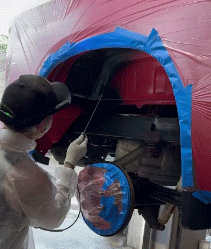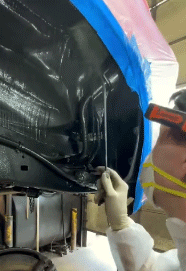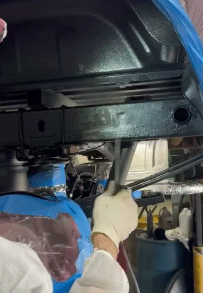Hey there, car lovers! If you’re like me, you treat your vehicle like family. So, when it comes to shielding it from rust and corrosion—especially in harsh winters—Waxoyl undercoating is my top pick. I’ve been through the wringer with rustproofing options, and Waxoyl’s durability and ease of use won me over. In this article, I’ll share my firsthand experience, break down the pros and cons, compare it to other brands, and spill my best tips for getting the most out of it. Trust me, you’ll want to give Waxoyl a shot!
My Waxoyl Journey: A Real-User Story

Let me take you back a couple of years. I live in upstate New York, where road salt is practically a food group in winter. My trusty 2015 Subaru Outback was starting to show speckles of rust under the wheel wells, and my heart sank. I’d heard horror stories about rust eating away at cars, so I dove into research mode. After sifting through forums, YouTube videos, and local shop recommendations, Waxoyl kept popping up. I decided to give it a whirl, and boy, am I glad I did.
I went the DIY route, grabbing a Waxoyl starter kit from a distributor. The process wasn’t exactly a walk in the park (more on that later), but seeing my car’s undercarriage coated in that glossy, protective wax felt like giving it a superhero cape. Two years later, no new rust spots, and my Subaru’s still kicking strong. That’s my story, but let’s dig into the nitty-gritty so you can decide if Waxoyl’s right for you.
The Pros Of Waxoyl Undercoating: Why I Love It
Waxoyl’s got a lot going for it, and I’m not just saying that because I’m a fanboy. Here’s why it’s been a game-changer for me:
Also Read: My Thought on Kayme Car Cover Review
- Long-lasting protection: Once applied, Waxoyl forms a tough barrier that sticks around for years. I’ve gone two winters without reapplying, and my car’s underbody still looks pristine.
- Rust-killing power: It doesn’t just prevent rust; it stops existing surface rust in its tracks. Those early rust speckles on my Subaru? Gone, or at least not spreading.
- Creeps into crevices: The wax seeps into seams and tight spots where rust loves to hide. It’s like a ninja, getting where sprays often miss.
- Sound dampening: I noticed my rides got quieter after applying Waxoyl. It cuts down road noise, making long drives more chill.
- Safe for car parts: It won’t harm paint, rubber, or electrical bits. I coated my wheel wells without worrying about ruining anything.
- Flexible finish: Unlike hard coatings, Waxoyl stays pliable, so it won’t crack when your car flexes over bumps. My off-road trails haven’t fazed it.
- Eco-friendlier vibes: It’s got fewer nasty chemicals than some traditional undercoatings. I feel better knowing I’m not harming the planet as much.
- DIY-friendly: With the right tools, you can apply it yourself. I saved a chunk of cash doing it in my garage.
- Trusted reputation: Waxoyl’s been around for over 50 years. That kind of track record gives me confidence it’s not some fly-by-night product.
- Resale value boost: A rust-free undercarriage makes your car more appealing to buyers. I know my Subaru’s value is holding strong.
Each of these perks has made my life easier. The peace of mind knowing my car’s protected? Priceless. Plus, the quieter rides are a nice bonus when I’m blasting my road-trip playlist.
The Cons Of Waxoyl Undercoating: Keeping It Real

No product’s perfect, and Waxoyl’s got its quirks. Here’s what I’ve learned to live with—or work around:
- Messy application: Applying it is like wrestling a tar monster. It drips, it sticks, and cleanup’s a pain. I ruined a pair of jeans my first go.
- Prep work is intense: You’ve got to clean and dry your car’s undercarriage thoroughly. I spent hours scrubbing mine to avoid trapping dirt.
- Not a rust cure-all: It slows deep rust but won’t fix structural damage. My buddy ignored heavy rust, applied Waxoyl, and regretted it.
- Weather sensitivity: Cold weather makes Waxoyl thick and hard to spray. I had to warm my garage to get it flowing right.
- Reapplication needed: It’s not a one-and-done deal. I’ll probably touch up high-wear areas next year to keep it tip-top.
- Costly upfront: The starter kit and tools aren’t cheap—mine ran about $200. Professional jobs can hit $1,000 or more.
- Solvent smell: The application process stinks like a paint shop. I wore a mask and kept my garage ventilated to avoid a headache.
- Learning curve: DIY isn’t plug-and-play. My first attempt was patchy until I watched more tutorials and got the hang of it.
- Not abrasion-proof: Gravel and debris can scrape it off over time. My skid plates took a beating off-road, needing spot fixes.
- Time-consuming: Between prep, application, and cleanup, I burned a full weekend. If you’re short on time, this might stress you out.
These downsides aren’t dealbreakers, but they’re worth knowing. If you’re patient and willing to put in the effort, Waxoyl’s rewards outweigh the hassle.
Maintenance And Tips: Getting The Most Out Of Waxoyl
To make Waxoyl work its magic, you’ve got to treat it right. Here’s how I maximize its benefits and keep my car rust-free:
- Clean like a pro: Pressure-wash your undercarriage before applying. I use a degreaser to zap grime—any leftover dirt can trap moisture.
- Dry thoroughly: Water is rust’s BFF, so let your car air out for a day. I parked mine in the sun to ensure no damp spots.
- Warm it up: Heat the Waxoyl can in warm water (not boiling!) for smoother spraying. It saved me from clogging my sprayer.
- Use the right tools: A quality spray gun with wands is a must. My kit’s long nozzles reached every nook of my Subaru’s frame.
- Apply evenly: Go slow and layer thin coats. I rushed my first try and had to redo spots where it pooled unevenly.
- Check annually: Inspect high-wear areas like wheel wells yearly. I caught a scraped patch early and touched it up before rust set in.
- Avoid steam cleaning: High heat can melt Waxoyl off. I stick to regular car washes and skip the undercarriage blast.
- Store properly: Keep leftover Waxoyl sealed in a cool, dry place. Mine’s still good for touch-ups after two years.
- Mask sensitive areas: Tape off exhausts and heat shields. I learned the hard way that overspray’s a pain to remove.
- Ventilate your workspace: Open garage doors and use fans. The fumes gave me a dizzy spell until I got airflow going.
Following these tips has kept my Waxoyl coating in fighting shape. It’s like maintaining a relationship—put in the work, and it’ll last.
Waxoyl Vs. Other Brands: How It Stacks Up
I’ve tried or researched plenty of rustproofing options, so let’s see how Waxoyl holds its own against the competition.
Waxoyl vs. Fluid Film

- Creeping ability: Fluid Film’s oil-based formula creeps better into seams. I used it on my tractor, and it reached spots Waxoyl might miss.
- Durability: Waxoyl lasts longer—Fluid Film needs yearly reapplication. My car’s coating is still solid after two years.
- Mess factor: Fluid Film’s gooey residue attracts dirt. Waxoyl’s tacky finish stays cleaner in my experience.
- Application: Fluid Film’s easier to spray in cold weather. I struggled with Waxoyl’s thickness on a chilly day.
- Smell: Fluid Film has a sheep-like lanolin odor, which I prefer over Waxoyl’s solvent stench.
- Cost: Fluid Film’s cheaper per can, but Waxoyl’s longevity evens it out. I spent less over time with Waxoyl.
- Eco-impact: Both are relatively green, but Waxoyl’s wax base feels less oily and wasteful to me.
- Finish: Waxoyl’s hardwax is tougher against scrapes. Fluid Film washed off my skid plates faster.
- DIY ease: Fluid Film’s forgiving for beginners. Waxoyl’s learning curve tripped me up at first.
- Availability: Fluid Film’s easier to find in stores. I had to order Waxoyl online, which took a week.
Fluid Film’s great for quick jobs, but Waxoyl’s my pick for long-term protection.
Waxoyl vs. Dinitrol
- Penetration: Dinitrol’s grease-like formula digs into rust better. I saw it work wonders on a friend’s rusty Land Rover.
- Longevity: Waxoyl edges out slightly—Dinitrol needs touch-ups sooner in my salty region.
- Application ease: Dinitrol sprays smoother without thinning. Waxoyl’s weather fussiness annoyed me.
- Cost: Dinitrol’s pricier, especially for DIY kits. Waxoyl’s price felt fairer for my budget.
- Odor: Dinitrol’s less smelly, which I appreciated when coating indoors. Waxoyl’s fumes were rough.
- Flexibility: Both stay pliable, but Waxoyl’s hardwax feels sturdier on exposed areas like my wheel wells.
- Prep needs: Dinitrol forgives minor dirt better. Waxoyl demands a spotless surface, which was tedious.
- Coverage: Waxoyl’s fogging reaches cavities well. Dinitrol’s thicker coat missed some of my car’s seams.
- Reputation: Both are trusted, but Waxoyl’s longer history gave me extra confidence.
- Maintenance: Dinitrol’s softer film needs more frequent checks. Waxoyl’s been low-maintenance for me.
Dinitrol’s solid, but Waxoyl’s balance of durability and coverage wins for my daily driver.
Waxoyl vs. Woolwax
- Thickness: Woolwax is thicker, clinging like a champ. It coated my trailer’s frame like armor.
- Longevity: Waxoyl lasts a bit longer in harsh conditions. Woolwax started thinning after a year.
- Application: Woolwax sprays easier without warming. Waxoyl’s prep and heating steps slowed me down.
- Cleanup: Woolwax is a nightmare to remove from skin. Waxoyl’s solvent-based mess cleans up with mineral spirits.
- Cost: Woolwax is slightly cheaper upfront. Waxoyl’s kit cost more but stretched further.
- Smell: Woolwax’s lanolin scent is milder. Waxoyl’s chemical whiff lingered in my garage.
- Durability: Waxoyl’s hardwax resists gravel better. Woolwax scraped off faster on my off-road paths.
- Eco-factor: Both are eco-okay, but Woolwax’s natural base feels a tad greener.
- DIY friendliness: Woolwax is simpler for newbies. Waxoyl’s tools intimidated me at first.
- Finish: Waxoyl’s tacky coat attracts less dust. Woolwax’s stickiness grabbed dirt like a magnet.
Woolwax is awesome for quick protection, but Waxoyl’s tougher finish suits my long-term needs.
Waxoyl vs. Traditional Rubberized Undercoating
Also Read: My Thought on Kayme Car Cover Review
- Flexibility: Waxoyl’s wax stays bendy, while rubberized coatings crack. My old truck’s rubber coating flaked off fast.
- Weight: Rubberized stuff is heavy, dragging fuel efficiency. Waxoyl’s light coat didn’t bog my Subaru down.
- Application: Rubberized is easier to slap on thick. Waxoyl’s precision spraying took practice.
- Rust protection: Waxoyl creeps into seams better. Rubberized coatings trapped moisture on my buddy’s Jeep.
- Removal: Waxoyl wipes off with solvent; rubberized needs grinding. I cursed scraping my old coating off.
- Noise reduction: Both dampen sound, but Waxoyl’s lighter layer quiets my rides more subtly.
- Cost: Rubberized is cheaper at shops, but Waxoyl’s DIY kit saved me money long-term.
- Durability: Waxoyl resists abrasion better. Rubberized chipped away on my gravel roads.
- Eco-impact: Waxoyl’s greener than solvent-heavy rubberized formulas. I like that for my conscience.
- Maintenance: Rubberized needs less upkeep but traps rust. Waxoyl’s inspections are worth the effort.
Rubberized coatings are old-school, but Waxoyl’s modern edge keeps my car safer.
Frequently Asked Questions (Faq)
Absolutely, if you live in a rust-prone area like I do. The upfront cost stings (mine was $200 for DIY), but it’s cheaper than rust repairs or a new car. My Subaru’s underbody is still clean after two years, which screams value to me.
In my experience, about 2-3 years before needing touch-ups, depending on your driving conditions. I’m planning a refresh next spring for high-wear spots, but the main coat’s still solid.
You bet! I did it with a starter kit and some elbow grease. It’s messy and takes a weekend, but watching tutorials helped me nail it. If you’re not handy, a pro’s worth considering.
Conclusion: Waxoyl’s Worth It—Trust Me
Alright, folks, here’s the deal: Waxoyl undercoating is hands-down one of the smartest investments you can make for your car. My Subaru’s rust-free undercarriage is living proof that this stuff works wonders. It’s not perfect—application’s messy, and prep’s a chore—but the protection and peace of mind are unbeatable. Whether you’re battling salty roads or just want your ride to last, Waxoyl’s got your back. Grab a kit, roll up your sleeves, and give your car the armor it deserves. You won’t regret it!
